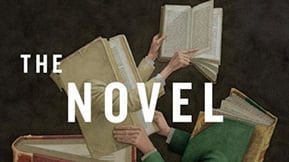On the second of the 1,106 pages in his new book, The Novel: A Biography, Michael Schmidt claims without apparent irony that he is writing “what sets out to be a brief life of the novel in English.” Since the hero of his biography has lived for over 600 years in the works of thousands of practitioners, a mere 1,106 pages might be excused as a brief life. But any biographer of the novel faces a problem more fundamental than compressing between two covers a vast and unwieldy subject. It’s also essential—and surprisingly difficult—to articulate what exactly defines a novel.
Cormac McCarthy once said that a novel can “encompass all the various disciplines and interests of humanity.” It’s an astonishingly ambitious claim for the novel-as-universe: a realm that can accommodate a near infinity of subjects and themes. In a less approving remark, Henry James highlighted the same quality of heterogeneous breadth in his famous description of 19th-century novels as “large loose baggy monsters.” Two of McCarthy’s favorite novels—Moby Dick and The Brothers Karamazov—are just such monsters, spanning subjects as diverse as moral philosophy and marine biology. For McCarthy, monstrousness is a potential strength; for James, it can manifest as lumbering, unattractive shagginess.
However evocative their descriptions, neither McCarthy nor James offer particularly helpful criteria for identifying the essential attributes of a novel. And turning from novelists to lexicographers isn’t illuminating. The OED defines a novel as “a fictitious prose narrative or tale of considerable length … representing character and action with some degree of realism; a volume containing such a narrative.”
Exceptions challenge every element of the definition. It might seem obvious to say that novels are “fictitious,” but certain ones are composed almost entirely of facts. Daniel Defoe’s A Journal of the Plague Year was originally read as a nonfiction account because it was based on journals and historical research. Truman Capote’s In Cold Blood is another hybrid, a work he called a “nonfiction novel.” The book’s material comes from the meticulous reporting of facts, though its methods of narration are novelistic. Dave Eggers wrote What Is The What after conducting hundreds of hours of interviews with his protagonist. He occasionally tweaked the chronology to shape the story in a compelling arc, but it would be perverse to describe this or many other novels as primarily “fictitious.”
Limiting a novel to a “prose” narrative is also questionable. As Schmidt points out, the very title of Alexander Pushkin’s Eugene Onegin: A Novel in Verse shows that some writers do not consider poetry incompatible with the novel. The poet Anne Carson also described her Autobiography of Red as a novel in verse, while works like Vladimir Nabokov’s Pale Fire mingle long stretches of poetry with prose.
Only the “narrative or tale” part of the definition remains, but a robust tradition of denying readers the satisfactions of narrative extends back at least as far as the compulsive digressions of Laurence Sterne’s Tristram Shandy. James Joyce and Virginia Woolf are only two of many 20th-century modernists whose novels often burrow deep inside a small unit of time rather than sequentially narrating events to form a traditional tale.
The final stipulation that a novel involves “representing character and action with some degree of realism” is a careful dodge that clarifies little. Read too strictly, this would exclude highly inventive works of science fiction and fantasy because they lack realism. Interpreted more broadly, the phrase loses meaning: what constitutes the necessary threshold of realism?
The novel is a gifted escape artist, skilled at shrugging off the chains of any definition. It crashes through the borders that usually separate verse and prose, real and imaginary, epistle and diary, essay and narrative. If it were a biological organism, its species definition would look something like this: “Has four legs, sometimes, but often has two or eight legs, and occasionally six. It tends to have fur, though it can also be covered in scales; it gives birth to live young, but occasionally lays eggs, and it’s a vertebrate, at least usually.” Only a post-apocalyptic world stewing in radiation could produce species that mutate as rapidly and playfully as the novel has over its history. Imagining novels as biological specimens creates a crazed and mythic zoology of hybrids, beasts, mutants, and aberrations.
Since a definition that enumerates essential features fails to capture the teeming variety of the form, perhaps another kind of definition is necessary. In Northanger Abbey, Jane Austen defends the novel against critics who dismiss it as frivolous and feminine. She describes a good novel as a “work in which the greatest powers of the mind are displayed, in which the most thorough knowledge of human nature, the happiest delineation of its varieties, the liveliest effusions of wit and humor, are conveyed to the world in the best-chosen language.”
Austen does no better than the lexicographers at delineating a set that comprises all but only novels. An excellent book of popular psychology written in stylish and witty prose satisfies her criteria (like some of Steven Pinker’s), while many powerful novels lack wit and humor (like most of J.M. Coetzee’s).
But Austen’s definition is really an argument about what the novel can and should be. It’s a prescriptive claim masquerading as a descriptive one. Northanger Abbey, after all, parodies the tropes and excesses of sentimental Gothic novels. Austen is perfectly aware that many books called novels do not display “the greatest powers of the mind.” They use contrived plots, poorly chosen language, and represent only a superficial and narrow sample of the varieties of human nature.
She avoids an exhaustively descriptive definition because she opposes condemning all novels based on the flaws of some novels. Those bad and silly ones aren’t really novels, she suggests. The form is defined by the realization of its highest and best potential. Inferior specimens don’t count.
Many novelists seem to agree that quality should be part of the definition of the novel. Perhaps truly terrible books aren’t really novels. Consider Mark Twain’s scathing criticism of James Fenimore Cooper’s The Deerslayer. “Its humor is pathetic; its pathos is funny … its love scenes odious; its English a crime against the language. Counting these out, what is left is Art. I think we must all admit that.”
It’s appealing to include some minimum quality standards in the definition of “Art” in general and the novel in particular. If I tossed together various parts of engines and scrap metal and declared the haphazard results a vehicle, you could reasonably object that my intention to make a car doesn’t guarantee that I have succeeded. Meeting an additional objective standard is necessary: can the vehicle safely transport you from one place to another?
Most people could agree on whether a given configuration of materials is a functioning vehicle or a useless set of parts. Quite the opposite is true for fiction. From someone’s point of view, every novel fails. The poet Randall Jarrell put it best: “The novel is a prose narrative of some length that has something wrong with it.”
James Fenimore Cooper’s novels utterly failed to transport Mark Twain to the American frontier of the early 18th century. Alexander Dumas, Franz Schubert, and Hector Berlioz, however, are only some of the more famous fans of Cooper’s fiction. Twain’s jalopy is their Porsche. As the Latin maxim puts it: De gustibus non est disputandum. (There is no disputing taste.)
Schmidt’s book makes quite clear, however, that much of the history of the novel is a long and bitter dispute about taste. Watching novelists insult one another is one of the primary pleasures of his biography. Flaubert, for instance, hated the works of Dickens: “What defective composition!” He then added, unhelpfully, “All English writers are the same; Walter Scott excepted, all lack a plot.”
Ford Madox Ford raged against English novelists from Henry Fielding to George Meredith. He observed that they “seem to cut their characters out with hatchets and to color them with the brushes of house-painters.” One of the few English authors he admired was Samuel Richardson. But Thackeray dismissed Richardson’s writing as “endless volumes of sentimental twaddle.” And Dr. Johnson remarked that “if you were to read Richardson for the story, your impatience would be so much fretted that you would hang yourself.” Consensus is a rare commodity among canonical authors.
Virginia Woolf loved Wuthering Heights and considered Emily Brontë superior to her sister Charlotte. George Orwell, however, thought Wuthering Heights was “perverse and morbid,” while Henry James despised “the crude and morbid story of Wuthering Heights.” (A recurring feature of Schmidt’s book is Henry James saying nasty things about practically every other major novelist who preceded him.)
Some of the authors most revered by their contemporaries now languish in relative obscurity. Like Flaubert, Tolstoy and Stendhal greatly admired Walter Scott. And Byron declared that the 18th-century Gothic novelist Horace Walpole was “surely worthy of a higher place than any living writer.” Scott and Walpole have drifted into the role of peripheral characters in the story of the novel, but they once struck their eminent peers as central figures. The opposite phenomenon also occurs: neglected writers who ascend to prominence only posthumously. Melville may be the most famous example, but Kafka, Kate Chopin, and many others followed a similar trajectory.
Volatility of reputation and subjectivity of quality make it difficult to define the novel in terms of absolute excellence. So the implied standard of Twain and Austen—that only really good novels represent the form—is slippery; it generates enjoyable debate and lively insults, but it doesn’t clarify the basic mystery of the novel’s essence.
Nor, ultimately, does Schmidt’s biography. He is a wonderful and penetrating critic, lucid and insightful about a dizzying range of novelists, but the subject of his book remains an enigma.
In The Art of the Novel, Milan Kundera proposes an intriguing solution: to understand the novel as a particular approach to knowledge and truth, a kind of epistemic stance. Kundera sees fiction as a realm of many partial truths, its only certainty “the wisdom of uncertainty.” To read a great novelist like Cervantes, he writes, is “to be obliged to face not a single absolute truth but a welter of contradictory truths (truths embodied in imaginary selves called characters).” The spirit of the novel is one of doubt and questioning; its knowledge is provisional and its perspectives multiple.
Kundera was reacting against the efforts of 20th-century totalitarian regimes to refashion novelists as propagandists. A novel that exists only to praise the merits of socialism is not a novel because it achieves nothing that is uniquely discoverable through the medium of fiction. A pamphlet or essay would work just as well. By this logic, George Orwell’s status as a novelist is also dubious. He criticized rather than praised the merits of powerful government, but he did so with unequivocal certainty.

Kundera’s position shades into sly self-contradiction. If the novel’s only certainty is the wisdom of uncertainty, this foundational certainty should also be doubted. If the certainty of the wisdom of uncertainty is itself uncertain, the force of the definition crumbles by logical standards.
This may be precisely the point: that fiction at its best is a sphere of suspended belief as much as suspended disbelief. It’s not that logic and truth cease to apply, but they tend to become self- cannibalizing, devouring their own presuppositions. And something of the novel’s spirit of uncertainty steals over attempts to crystallize the form’s essence: definitions ultimately vanish into the same fog of partial truths that suffuses the best novels.

